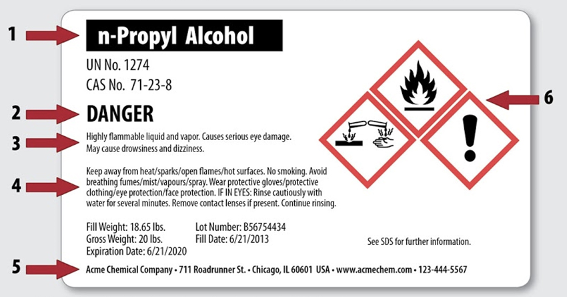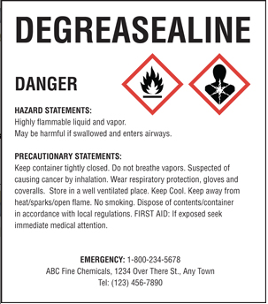GHS and BS 5609 Certified Labels and Ribbons for Chemical Labeling

Summary
IMP’s GHS/BS5609 Solutions WHAT IS GHS?
 Regulations require some labels to be marked according to GHS. According to the Environmental Protection Agency, “The Globally Harmonized System (GHS) of Classification and Labelling of Chemicals is a worldwide initiative to promote standard criteria for classifying chemicals according to their health, physical and environmental hazards. It uses pictograms, hazard statements, and the signal words “Danger” and “Warning” to communicate hazard information on product labels and safety data sheets in a logical and comprehensive way.
Regulations require some labels to be marked according to GHS. According to the Environmental Protection Agency, “The Globally Harmonized System (GHS) of Classification and Labelling of Chemicals is a worldwide initiative to promote standard criteria for classifying chemicals according to their health, physical and environmental hazards. It uses pictograms, hazard statements, and the signal words “Danger” and “Warning” to communicate hazard information on product labels and safety data sheets in a logical and comprehensive way. The primary goal of GHS is better protection of human health and the environment by providing chemical users and handlers with enhanced and consistent information on chemical hazards.”  As of June 1, 2015 manufacturers and distributors must reclassify their chemicals and produce GHS-formatted safety data sheets and labels for items shipping to downstream users.
As of June 1, 2015 manufacturers and distributors must reclassify their chemicals and produce GHS-formatted safety data sheets and labels for items shipping to downstream users.
 As of June 1, 2015 manufacturers and distributors must reclassify their chemicals and produce GHS-formatted safety data sheets and labels for items shipping to downstream users.
As of June 1, 2015 manufacturers and distributors must reclassify their chemicals and produce GHS-formatted safety data sheets and labels for items shipping to downstream users. GHS labeling requirements include domestic and international shipments. When shipping internationally, it’s imperative to understand the requirements of the receiving country. At times, additional but separate standards, such as BS5609 (saltwater submersion testing to ensure that the label will remain intact when a drum that’s fallen off a ship washes ashore), must be met.
The Anatomy of a GHS Label

- PRODUCT IDENTIFIER – matches the safety data sheet
- Signal words are DANGER or WARNING
- Hazard Statement - For each category of a class, a standardized statement is used to describe the hazard. For example, the hazard statement for chemicals which meet the criteria for the class Self-heating substances and mixtures, Category 1 is Self-heating; may catch fire. This hazard statement would appear both on the label and on the SDS
- Precautionary statement – describes recommended measures to minimize or prevent adverse effects resulting from exposure
- Supplier information – name address and phone number of the manufacturer or supplier
- Pictograms – graphical symbols intended to convey specific hazard information visually


Pictographs:

WHAT IS BS5609
BS5609 is the British Standard for pressure-sensitive adhesive labels used for marine applications. BS5609 is the standard that label adhesive and printed inks must meet (as a component of GHS) when they are used on hazardous chemical containers shipped by sea. BS5609 applies to the combination of label and printed inks, and certification is granted by one of several accredited testing labs throughout the world. Testing includes a 3-month exposure of labeled test plates in salt water.
- Section 2: tests the pressure-sensitive adhesive coated label base material (this includes the facestock, adhesive and any additional topcoats).
- Section 3 – tests the final printed label - label stock and print. The goal is to ensure that the print will remain legible in the event that a drum ends up in the ocean for a period of time.
HOW ARE GHS LABELS PRINTED
- Press-print the entire label
- Press-print the red and image the black with a thermal transfer or laser printer
- Image blank labels at the customer site - all of the information imaged with an inkjet, two-color thermal, or color laser printer.
Two color thermal transfer printers are a great option for GHS compliant labels. Two successively arranged thermal printheads permit simultaneous printing of two colors in one pass. Printing your labels on demand lets you print the number of labels you want, when you want with no excess inventory.
Printer Options – 2-color
- CAB
- Microplex
Printer Options – General Purpose Thermal Transfer Printers
- Zebra
- Datamax
- SATO
- Honeywell
IMP’s GHS/BS5609 Solutions
BS5609 Section 3 Certified Combinations
| Substrate Supplier | Material | Spec | IMP Ribbon |
|---|---|---|---|
| Avery | 3.7 mil Kimdura/S4600/50#SCK | 79572 | |
| Avery | 4 mil Transcode•/S475/50#SCK | 72197 |
Please note, the contents of GHS/BS5609 data on impzh.com is for informational purposes only, is general in nature, and is not intended to and should not be relied upon or construed as a legal opinion or legal advice regarding any specific issue or factual circumstance.





